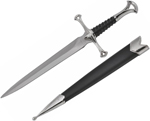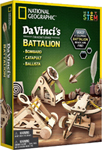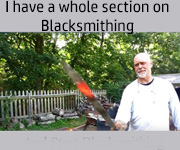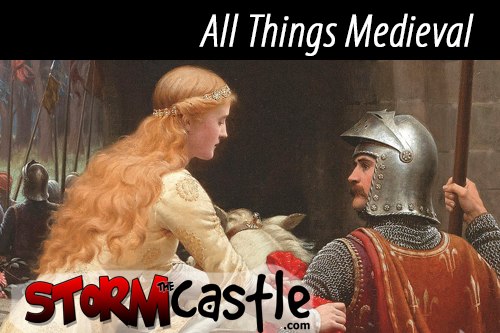
.
This is the medieval section of StormTheCastle.com
- Knights
- Castles
- Games
- Weapons/Armor
- Articles
- Medieval Names
- Medieval Words
- Medieval Terms
- Medieval Jobs
- Medieval Maps
Wills Books
Medieval Castles
We are not just talking about castles here, we are talking about "Medieval Castles" and this brings some very specific things to mind.
A castle is a large and beautiful stone structure that housed Kings and protected its people from the sieges and attacks of enemies. They were sometimes lavish and sometimes very plain.
Latest Article: The Siege of a Real Medieval Castle How Richard the Lion Hearted's Castle was sieged and taken in 1204 AD
The Puzzle of the Mysterious Medieval Chest - (A Real Story)
 I received an email from a gentleman looking to identify the castle depicted on this real 13th century medieval chest. Can you identify the castle? Look at more pictures and read the story of the chest here:
I received an email from a gentleman looking to identify the castle depicted on this real 13th century medieval chest. Can you identify the castle? Look at more pictures and read the story of the chest here:The Mysterious Medieval Chest (News Flash!) There have been some insights into this mystery! Read More And see bigger pictures
The Making of a Film In and Around a Real Medieval Castle (A Real Story) 
Medieval Castles are an amazing place to film a movie. I recently had the opportunity to interview the director of the upcoming History Channel film about the Dark Ages. Much of the film was shot in and around a real medieval castle . Read what the director has to say about the castle and the film. The Medieval Castle and the History Channel Presents The Dark Ages
But A Medieval Castle is....
A Medieval Castle is all of these things and more. When we think of Medieval Castles there is a dark a secretive feeling that we feel. A Medieval Castle was a castle, but it was also a place with a history, a place that had secrets and secret passages. It was a place where tremendous battles were fought to the death by knights.
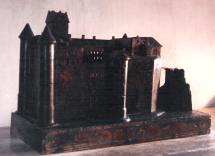
Let's Take a look at a real Medieval Castle! Here is a model of the Meersburg Castle -
An old legend and a 1548 document say that the creation of this impressive stronghold dates back to the 7th century which means this castle is possibly well over a thousand years old and still in perfect condition. It is located on Lake Constance in Germany.
Some of the things you would find in this castle would be a medieval living area, a Knights Hall, an Arms Hall, a well-room, a castle dungeon, chapels, guard's walkways and towers, the picturesque fortress garden and the defensible northern bastion, the workroom and death chamber of Annette von Droste-Hülshoff, the most popular German poetess who lived in the fortress during her stays at Lake Constance. Can you see what I mean by a Medieval Castle is a place of mystery, secrets and stories?
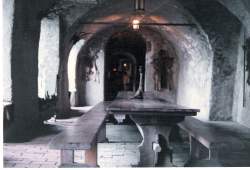
Inside the Knights Hall - This is a picture I took inside the Hall of the Knights. Of course the electric light was installed many centuries later. See how the windows are arranged to let a good amount of sunlight into the hall. Imagine the knights sitting at the table and making plans for defending against a sieging enemy.
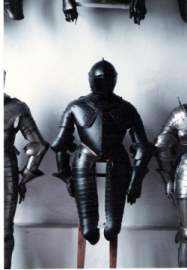
The tale of the Black Knight - Inside this Medieval Castle there is an armory where they have a variety of weapons and armor on display. One of the things that struck me was the size of the armor. It was quite small- as if the knights stood maybe five foot six at their tallest. Here is a picture of one of the suits of armor. It is black so I call it the Black Knights Armor. Do you think there is a story behind this armor? Why was it black? Who was the man who wore it and what deeds did he accomplish? This is a story that I wish the walls of this Medieval Castle could tell.
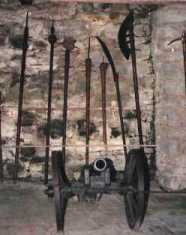
A picture of some of the weapons in the Armory - One of the biggest things to consider about Medieval Castles is that they were a place of life and death. These vicious polearm weapons show this. A Medieval Castle was built to withstand the onslaught of enemies bent on destruction. Life in a medieval castle was very serious business.
More About Medieval Castles
Medieval Castles are magnificent structures that were first created around the tenth century. These first castles were made of earth and wood.
- These early earth and wood castles were called Motte and Bailey and were made of a mound of earth (motte) topped with a wooden tower. And encircled by a protective wall ( bailey)
Over the centuries castles were improved for maximum fortification both offensive and defensive and on of the most important improvements was the fortification of the outside walls which were built thicker and thicker. This is predominantly because of the development of artillery.. They eventually were designed as fortified places for royalty to live.
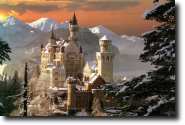 Of all the Medieval Castles in the world this one is the most famous. It is Neuschwanstein located in Bavaria Germany. Learn more about Neuschwanstein It is widely held that this is what the famous Disney castle is modeled after.
Of all the Medieval Castles in the world this one is the most famous. It is Neuschwanstein located in Bavaria Germany. Learn more about Neuschwanstein It is widely held that this is what the famous Disney castle is modeled after.
What is a Medieval Castle? The generally accepted definition of a castle is a structure that is fortified for defense against an enemy and generally serves as a military headquarters dominating the surrounding countryside.
What were the main purposes of a Castle? The basic function of a castle varied and their use changed over time. The three main uses of a castle are:
- A fortified building that was used in a defensive manner to protect the people from outside invaders.
- A fortified building that was used in an offensive manner. A king would often build a castle in a foreign or hostile land as a place to mount attacks from. This was one of the main ways that kingdoms were extended in size.
- A fortified building for people to live in. Over the course of centuries the function of a castle changed. It became more of a place for people and royalty to live in. The military applications and functions of castles were minimized and the livability was maximized. They still retained their flavor and feel of being fortified but considerably less so.
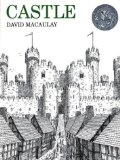 |
Want to Know How a castle is built? This Caldecott Medal winning book takes you through the whole process step-by-step. It is all done in pencil and pen and ink drawings and is simply maginificent. If you love to know how things are made you should check out this book. Castle |
When were the first Castles Built? It is generally accepted that the first castles were built around the tenth century in the north of France. These early castles were built of earth and wood.
When we think of A "Medieval Castle" some very specific things come to mind. These are the machinations of warfare! How and why were castles built the way they were built? For defense and offense in time of war! Here is an overview of some of the more famous things about castles, their fortifications and how they were sieged.
Some of the Defensive Features of Medieval Castles
Concentric Walls A castle was often built with a stronghold in the very center. This was the last line of defense. Remember that peoples lives depended on their castles so they were very cautious and took extreme measures. Around this stronghold they built a wall then around this wall they built another wall and even sometimes a third wall around all of this. The purpose of this was that if the outer wall was breached by an invading enemy everyone could retreat to an inner set of walls and the siege could begin again. It was like having a castle within a castle. the invaders would have to commence the seiging all over again and again.
|
Moats - A Moat is a deep and wide water-filled trench that circled all the way around a castle. It served two main purposes. It made it very difficult for a seiging army to get their seige machines such as siege toward and battering rams up against the castle walls. This was the only way they were effective. A common tactic of a sieging army was to dig a hole under a castle wall rather than try to break it down. A moat around the castle made this very difficult.
Drawbridges - This is a large wooden bridge that crossed over the moat of a castle. It could be let down and used as a bridge in times of peace. But in times of trouble or siege it could be raised - effectively making it more difficult for the seiging army to invade the castle.
Portcullises - These are heavily fortified iron gates that were raised and lowered vertically. this was usually one of the last lines of defense in a castle and they were often used in pairs. A short tunnel would be at the entrance to the castle with a portcullis on each end of it. the portcullis on the inside would be closed and then when invaders entered the tunnel the portcullis on the outside would be closed. This would trap the invaders inside the tunnel where they could be easily handled by arrows, hot oil or other means.
Battlements - This picture show the battlements of this castle. They were crennelated shapes along the top of a castle that allowed people to shoot arrows or other projectiles down at their enemies. .
 Another view of battlements Can you see how easy it would be for people to stand up here and shoot arrows down on the enemy?
Another view of battlements Can you see how easy it would be for people to stand up here and shoot arrows down on the enemy?
As Technology in weapons increased (particularly with the creation of artillery) castles became more and more fortified. But castles could be breached and overcome. This was called sieging.
Continue on to the next section: How Castles were sieged And learn how to make a siege engine so you can siege a castle yourself!
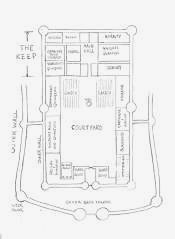
Want to see a castle floor Plan? See the major parts of a castle and the why and how of their design. Castle Floor Plans and explanations
Second Sub title gray color
Gold Box sub title
Consectetur adipisicing elit. Praesentium magnam consectetur vel in deserunt aspernatur est reprehenderit sunt hic. Nulla tempora soluta ea et odio, unde doloremque repellendus iure, iste.
Some Medieval Items on Amazon for you
These are affiliate links, Will makes a small percentage of the sale
I have picked some best sellers for you
King Arthur Medeival short sword dagger - Medieval Chainmail Coif - DaVinci's Battalion



